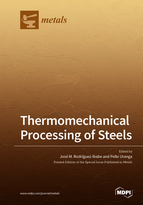Thermomechanical Processing of Steels
A special issue of Metals (ISSN 2075-4701). This special issue belongs to the section "Metal Casting, Forming and Heat Treatment".
Deadline for manuscript submissions: closed (20 February 2020) | Viewed by 49346
Special Issue Editors
Professor at Universidad de Navarra-Tecnun, Materials Science and Metallurgy, Universidad de Navarra-Tecnun, M. Lardizabal 15, 20018 Donostia-San Sebastian, Basque Country, Spain
Interests: microstructure; microscopy; thermomechanical processing; microalloying; steels; metallurgy; modelling
Interests: thermomechanical processing; microstructural evolution modeling; microalloying; microstructure–property relationship
Special Issues, Collections and Topics in MDPI journals
Special Issue Information
Dear Colleagues,
The combination of hot working technologies with a thermal path, under controlled conditions, i.e., thermomechanical processing, provides opportunities to achieve required mechanical properties at lower costs. The replacement of conventional rolling plus post-rolling heat treatments by integrated controlled forming and cooling strategies implies important reductions in energy consumption, increases in productivity and more compact facilities in the steel industry. The metallurgical challenges that this integration implies, though, are relevant and impressive developments that have been achieved over the last 40 years. The development of new steel grades and processing technologies devoted to thermomechanically-processed products are increasing and their implementation is being expended to higher value added products and applications.
The achievement of mechanical properties and process stability during a Thermomechanical Controlled Process (TMCP), depend on the chemical composition, process parameter control and optimization, as well as post-forming cooling strategy and thermal treatments. Therefore, this Special Issue would like to combine contributions on different fields, topics, steel grades and forming technologies applying TMCP processes to steels. Papers regarding forming technologies, such as rolling, forging, hot-stamping, etc., using microalloyed, medium/high Mn or alternative high alloyed grades will be welcome. New technologies, such as near-net-shape production, innovative cooling strategies, such as direct quenching, quenching and partitioning or additional controlled cooling strategies will be the base for current and future new product developments.
In addition to the metallurgical peculiarities and relationships between chemical composition, process and final properties, the impact of advanced characterization techniques and innovative modelling strategies provides new tools to achieve further deployment of the TMCP technologies.
For this Special Issue on "Thermomechanical Processing of Steels", we would like to invite researchers from the steel industry and academia to submit their latest developments and achievements in the field.
Prof. Dr. José María Rodríguez-Ibabe
Dr. Pello Uranga
Guest Editors
Manuscript Submission Information
Manuscripts should be submitted online at www.mdpi.com by registering and logging in to this website. Once you are registered, click here to go to the submission form. Manuscripts can be submitted until the deadline. All submissions that pass pre-check are peer-reviewed. Accepted papers will be published continuously in the journal (as soon as accepted) and will be listed together on the special issue website. Research articles, review articles as well as short communications are invited. For planned papers, a title and short abstract (about 100 words) can be sent to the Editorial Office for announcement on this website.
Submitted manuscripts should not have been published previously, nor be under consideration for publication elsewhere (except conference proceedings papers). All manuscripts are thoroughly refereed through a single-blind peer-review process. A guide for authors and other relevant information for submission of manuscripts is available on the Instructions for Authors page. Metals is an international peer-reviewed open access monthly journal published by MDPI.
Please visit the Instructions for Authors page before submitting a manuscript. The Article Processing Charge (APC) for publication in this open access journal is 2600 CHF (Swiss Francs). Submitted papers should be well formatted and use good English. Authors may use MDPI's English editing service prior to publication or during author revisions.
Keywords
- Thermomechanical processing
- Steels
- Hot working
- Phase transformations
- Microstructure
- Mechanical properties
- Modelling







